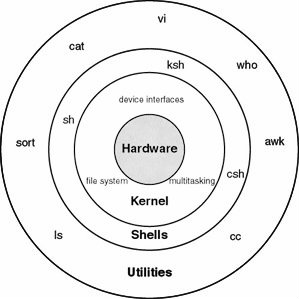Top 3 Products & Services
| 1. 2. 3. |
Dated: Aug. 13, 2004
Related Categories
UnixTo understand why the UNIX operating system has so many commands and why it’s not only the premier multiuser, multitasking operating system, but also the most successful and the most powerful multichoice system for computers, you’ll have to travel back in time. You’ll need to learn where UNIX was designed, what were the goals of the original programmers, and what has happened to UNIX in the subsequent decades.
Unlike DOS, Windows, OS/2, the Macintosh, VMS, MVS, and just about any other operating system, UNIX was designed by a couple of programmers as a fun project, and it evolved through the efforts of hundreds of programmers, each of whom was exploring his other own ideas of particular aspects of OS design and user interaction. In this regard, UNIX is not like other operating systems, needless to say!
It all started back in the late 1960s in a dark and stormy laboratory deep in the recesses of the American Telephone and Telegraph (AT&T) corporate facility in New Jersey. Working with the Massachusetts Institute of Technology, AT&T Bell Labs was codeveloping a massive, monolithic operating system called Multics. On the Bell Labs team were Ken Thompson, Dennis Ritchie, Brian Kernighan, and other people in the Computer Science Research Group who would prove to be key contributors to the new UNIX operating system.
When 1969 rolled around, Bell Labs was becoming increasingly disillusioned with Multics, an overly slow and expensive system that ran on General Electric mainframe computers that themselves were expensive to run and rapidly becoming obsolete. The problem was that Thompson and the group really liked the capabilities Multics offered, particularly the individual-user environment and multiple-user aspects.

In that same year, Thompson wrote a computer game called Space Travel, first on Multics, then on the GECOS (GE computer operating system). The game was a simulation of the movement of the major bodies of the Solar System, with the player guiding a ship, observing the scenery, and attempting to land on the various planets and moons. The game wasn’t much fun on the GE computer, however, because performance was jerky and irregular, and, more importantly, it cost almost $100 in computing time for each game.
In his quest to improve the game, Thompson found a little-used Digital Equipment Corporation PDP-7, and with some help from Ritchie, he rewrote the game for thePDP-7. Development was done on the GE mainframe and hand-carried to the PDP-7 on paper tape.
Once he’d explored some of the capabilities of the PDP-7, Thompson couldn’t resist building on the game, starting with an implementation of an earlier file system he’d designed, then adding processes, simple file utilities (cp, mv), and a command interpreter that he called a "shell.” It wasn’t until the following year that the newly created system acquired its name, UNIX, which Brian Kernighan suggested as a pun on Multics.
The Thompson file system was built around the low-level concept of i-nodes—linked blocks of information that together comprise the contents of a file or program—kept in a big list called the i-list, subdirectories, and special types of files that described devices and acted as the actual device driver for user interaction. What was missing in this earliest form of UNIX was path names. No slash (/) was present, and subdirectories were referenced through a confusing combination of file links that proved too complex, causing users to stop using subdirectories. Another limitation in this early version was that directories couldn’t be added while the system was running and had to be added to the preload configuration.
In 1970, Thompson’s group requested and received a Digital PDP-11 system for the purposeof creating a system for editing and formatting text. It was such an early unit that the first disk did not arrive at Bell Labs until four months after the CPU showed up. The first important program on UNIX was the text-formatting program roff, which—keep with me now—was inspired by McIlroy’s BCPL program on Multics, which in turn had been inspired by an earlier program called run off on the CTSS operating system.
The initial customer was the Patent Department inside the Labs, a group that needed a system for preparing patent applications. There, UNIX was a dramatic success, and it didn’t take long for others inside Bell Labs to begin clamoring for their own UNIX computer systems.
Now that you've gotten free know-how on this topic, try to grow your skills even faster with online video training. Then finally, put these skills to the test and make a name for yourself by offering these skills to others by becoming a freelancer. There are literally 2000+ new projects that are posted every single freakin' day, no lie!
 Previous Article |  Next Article |

